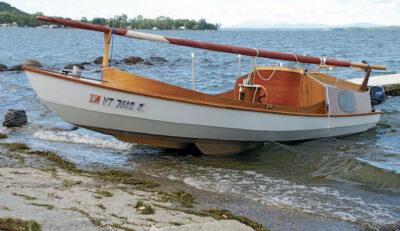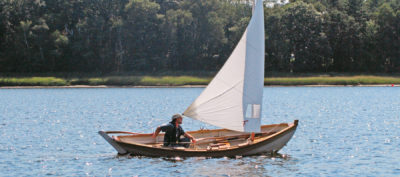 George D. Jepson
George D. JepsonThe Bay Pilot 18, designed by Arch Davis, is a swift cruiser that accommodates up to four adults during day outings, or two for overnight excursions.
NATARA, a Bay Pilot 18 designed by Arch Davis (see WoodenBoat No. 190), is reminiscent of a cabin cruiser from an earlier era as she skims across the sparkling waters of Roberts Bay at Venice, Florida, powered by a quiet, 60-hp four-stroke outboard motor. At 18′ LOA, with a 7′ 3″ beam and 8″ draft, this pocket yacht belies her dimensions, having the look and feel of a larger boat.
Owner and builder Bob Bridges, a retired sales and marketing executive, weighed various designs and was ultimately drawn to the Bay Pilot 18’s traditional look and accommodations. A bottle green hull and brilliant white deck, separated by a Douglas-fir rubrail, add to the boat’s classic appearance.
The modest V-bottomed hull is seakindly in a light chop and leaves a clean wake, though in heavier seas caution should be the watchword, with speed reduced according to conditions. Fishermen will appreciate the boat’s stability. The Bay Pilot 18 is ideal for cruising along saltwater coasts or in the sweet waters of the Great Lakes, rivers, and inland lakes. Davis recommends outboard power ranging between 30 and 60 hp, with either single or twin configurations.
NATARA, named for Bridges’s daughters, Natalie and Tamara, has a sizable open cockpit, with the helm located amidships on a console attached to the forward bulkhead. The console also accommodates electronic instrumentation. A swivel chair secured to the deck next to the throttle offers a comfortable seat for the helmsman. The surprisingly roomy cabin, entered through a step-down companionway, features a V-berth and space for a portable head. The berth is ideal for an afternoon snooze and otherwise is a good place for dry storage.
Bridges eliminated the built-in fore-and-aft seats specified in the drawings, using the space instead for fishing gear—bait boxes, tackle boxes, and poles. Collapsible canvas chairs provide comfortable seating for Bridges’s wife, Laine, and a couple of additional adult passengers.
 George D. Jepson
George D. JepsonNATARA’s open cockpit features a starboard steering console, which flanks a step-down companionway leading to V-berths below, with space for a portable head.
Although NATARA is trailerable, Bridges prefers the convenience of keeping the boat overboard in a slip. “Just unsnap the cockpit cover, turn the key, throw off the docklines, and you’re ready to go,” he said. Within minutes, he and his wife can be drifting along in the Gulf of Mexico or cruising the Intracoastal Waterway.
At age 75, Bridges launched this 18-month building project in his 21′ × 21′ two-stall attached garage. Family vehicles were banished to the driveway for the duration. By the time NATARA was launched, he had expended over 1,500 hours.
“Positioning the boat catty-corner [diagonally] across the floor gave me plenty of room to work,” Bridges said. “Building in the garage has a lot of advantages. It’s right there if you have a couple of extra hours—and weather is never a factor.”
Fabricating the stem presented a challenge. “It was my first time working directly from plans, and it took some study and interpretation,” he said. “After that it became easier.” Other than the change in seating, Bridges followed Arch Davis’s original plans almost to the letter. He chose to exclude the hard top but retained Davis’s windshield scheme, while modifying the side windows “to look more like a picnic boat.” He added an external mahogany keel 1 3⁄4″ wide by 2″ deep, beginning about 3′ back from the forefoot and ending 3′ from the transom, which improved NATARA’s maneuverability at low speeds.
The boat’s pieces were primarily fabricated from two woods: 3⁄8″ or 3⁄4″ meranti marine plywood (bottom, decks, sides, bulkheads, cockpit, and the cabin sole) and Douglas-fir (stem, keel, frames, stringers, windshield frame, and deckbeams). The bottom was constructed of two layers (3⁄8″ and 1⁄4″) of meranti, and the transom was built of two layers of 3⁄4″ meranti glued together with epoxy.
 George D. Jepson
George D. JepsonAble to carry single or twin outboards, she has proven herself seaworthy in the open waters of the Gulf of Mexico.
Bridges worked with a variety of tools: a set of chisels, a small hand plane, two cordless electric drills (one for drilling pilot holes and countersinking and one for driving the screws), an 8″ circular saw, a 10″ tablesaw, a 3″ handheld power plane, and a router.
The lapstrake hull was built upside down on a jig. The two full-length stringers held the bulkheads, frames, and temporary molds. Planks were glued and screwed to these longitudinals and frames, which provided additional stiffness to the structure.
A significant challenge was bending plywood to fit the bottom. Bridges treated exterior surfaces of the panels with hot, moist towels to make them bendable, and then clamped them to the chines; this was the only stage of the project that required two sets of hands. Bending Douglas-fir was a simpler matter. An overnight soak in the family swimming pool left the wood pliable for clamping into place.
When the basic hull was completed, the builder faced another knotty problem—turning it over to work on the interior. After much contemplation he arrived at a simple solution: He invited the Venice High School coach and 10 linemen over for pizza and soda. Within 20 minutes, they were able to carry the hull outside, turn it over, bring it back into the garage, and set it on a Styrofoam block cradle.
 Arch Davis
Arch DavisThe Bay Pilot 18’s midsection shows a boat that is surprisingly roomy, belying her diminutive dimensions. Deadrise angle and flare in the forward sections promise a dry ride, while the wide-bodied aft sections mean that the ride will be comfortable, too.
Every surface on NATARA was sealed in epoxy. The bottom was sheathed with a layer of fiberglass cloth, two coats of epoxy, a coat of primer, and one coat of bottom paint. Topsides were primed and then received three coats of paint. A layer of fiberglass was laid down on the deck, which was primed and finished with topside paint mixed with nonskid compound. Frames in the cockpit, stringers, the cabin bulkhead, and beams were finished with varnish.
On a crisp and sunny Florida morning in February, we stepped aboard NATARA at her dock. The outboard turned over and purred softly. Lines were cast off, and the cruiser slid smoothly down the channel toward Roberts Bay. A slight breeze caressed the open water as the throttle was pressed forward. A trim wake stretched out behind us, as NATARA settled into a steady, comfortable ride at 20 mph, or about 17 1⁄2 knots.
 George D. Jepson
George D. JepsonNATARA was completed with an open cockpit, providing room for fishing gear, and allowing space for collapsible canvas chairs while cruising. Davis’s design offers permanent seating for four as an alternative.
Steering with the large stainless-steel wheel, I was whisked back to the 1950s and stints at the helm of my grandfather’s 24′ garage-built plywood cruiser on Lake Superior off Michigan’s Upper Peninsula. NATARA responded well and cornered nicely. Her compact size made maneuvering alongside docks effortless.
The Bay Pilot 18—a throwback to the years of Ike, Howdy Doody, Elvis Presley, Ed Sullivan, and the Cold War—is an affordable way to get on the water in a charming wooden boat with a modicum of luxury, whether picnicking, fishing, or overnighting in a secluded cove.![]()
Plans for the Bay Pilot 18 are available from Arch Davis Design

















Join The Conversation
We welcome your comments about this article. If you’d like to include a photo or a video with your comment, please email the file or link.